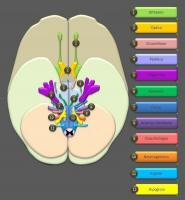Neuroanthropology: what it is and how it is investigated
In order to acquire precise knowledge about the human being, it is unavoidable to adopt a polyhedral vision, which bring together in your lap the various disciplines whose purpose is to describe what underlies your complex reality. From neuroscience to anthropology, all have the ability to provide answers to the eternal questions that our most curious species has formulated about itself.
Despite this, a notable independence between one and the other has traditionally been maintained, as if they were not needed to advance their fundamental objective. All of this meant that perspectives of greater integration were not deployed, more in line with the phenomenon that was desired to unravel, and that mistrust even arose between them.
In recent times, however, the need to establish alliances based on multidisciplinarity is completely undeniable. It is from them that the theoretical and practical heritage has been spreading and expanding, and with it all scientific development. Joining forces has never been as important as it is today, in societies as vast and unfathomable as the ones we have lived in.
In this article we will discuss in detail the characteristics of neuroanthropology, a theoretical framework and a method in which the humanistic and the empirical concur. From all this emerges an epistemology that motivates the coherent orchestration of what is known about the brain and about cultural relations.
- Related article: "Neuropsychology: what is it and what is its object of study?"
What is neuroanthropology?
Neuroanthropology is born from the confluence and harmony between ways of understanding the human fact, which in the past were antagonistic or independent: neurosciences (including neurology or psychology) and anthropology. Such a novel discipline, which was gestated and officially emerged in the early years of this century, makes culture the gravitational axis around which its action revolves. For this, it would have neuroscience as its main ally, since it would be through its consensus and evidence. of research that could extend its horizon beyond the traditional limits that have "handcuffed"
One of the principles of neuroanthropology, from which its existence is justified, is the analogy between psychology and culture.. Although neurological bases are usually recognized for the first of these without any hint of a doubt (as the mental and affective aspects are built in the brain), this is not the case in the second case. The objective would be to break with this biased view of the scope of cultural influences, and to also assume in them the ability to modulate the structure and functions of an organ that governs fundamental processes for its dynamics and its understanding.
The perspective of neuroanthropology indicates that culture is an explanatory element of human behavior as powerful (or even more so) than biological needs. And it is that the network of meanings common to all human collectivity depends on it, as well as the way in which the links that could be manifested within it are regulated. It is undeniable, therefore, that culture has a powerful component of a psychological nature, and that by having While this has extensive neurological roots, the culture itself must also have them, at least to some extent. degree.
This reasoning has served to shape its essential theoretical justification, and also has deep empirical evidence. And it is known that culture participates in some way in the highly complex maturation process of the central nervous system, including both its functions and its structure. There are many studies that have shown the role of everything cultural in perception (orientation of attentional resources in environments complex), social processing ("subjective" assessment of the behavior of others), emotional experience (affective reactions to events individuals), language (system through which communication is established between two individuals) and the attribution process for the causes and the effects; all of them related to specific areas of the brain.
From all this it can be deduced that the cultural and the social, foundations of anthropology, are important to understand our species. What current science indicates is that the two are potentially explanatory variables for "differential" patterns of activation. brain that have been evidenced when comparing subjects belonging to different human groups, which translates into disparate experiences among them. Neuroanthropology would seek to offer the answer to an unresolved question over decades of neuroscientific study: Where are shared meanings located at a brain level and how do the mechanisms involved evolve?
Next, we will elaborate on the objectives and the method of this humanist neuroscience, which is progressively is recognizing more importance within the multiplicity of disciplines whose purpose is to unravel the mystery of man.
Objectives of your research
The main objective of this neuroanthropology is to describe the transcultural and intercultural regularities (between cultures or within the same community), to identify eventual differences between two groups that could be attributable to the tacit effect of symbols and rules shared. That is why it resorts to both cross-sectional and longitudinal research designs: through the former, potential divergences would be found at a single moment in time between two groups, and with the latter their own evolution over time in a single community would be evidenced (due to environmental or relational changes that could have concur).
For the study of what has come to be called the "cultural brain", the latter would be more relevant, since they would allow an analysis of the neuroanatomical covariation linked to the basic processes of social learning and the experiences shared by the collectives of humans involved in their study. This mixture of sciences and knowledge, impossible to conceive just a few years ago, is the foundation of neuroanthropology as it is defined today.
In addition to this great purpose, neuroanthropology also aims to achieve a series of specific objectives. The first one looks for a definition of the existing correlations between the changes of cognitive-behavioral base that are associated with cultural aspects and the function or structure of the nervous system objectified by neuroimaging techniques. After that, it would be necessary to use statistical procedures to trace how they interact with each other. Finally, longitudinal studies would be projected through which to explore "in vivo" how this relationship unfolds in the environment where the subjects live (ecological validity).
In short, neuroanthropology describes human behaviors that unfold within a cultural framework (such as basic elements of coexistence), and tries to associate them with the cerebral substrates that could serve as support physical.
Once this analysis is done, we would proceed to compare what is known in a town with what happens in others, in a search for universal or specific keys that can correspond to the social aspects of all they. It is also intended delimit the mechanisms of brain change linked to diversity within the same human group, or originated by environmental/interpersonal fluctuations in which they have been able to participate. The independent variable in this case is, therefore, the culture itself.
Methods of this field of science
The method of neuroanthropology is of a humanist nature, but amalgamates resources common to empiricist science. Therefore, it combines the ethnography of social anthropology (which implies "immersing" in the communities that are being investigated, assuming their way of life during the period required by the project) and laboratory analysis, where the variable is manipulated independent. In this case, a field study would be conducted first (to collect data) and then quantitative experiments could be designed, always respecting the ethical norms on the preservation of societies.
This way of proceeding, which involves a series of two relatively independent phases (qualitative and quantitative), is called neuroethnography. With its application, the necessary sensitivity towards the object of analysis is preserved, which is none other than the social life of individuals and the symbology that they use to understand the world that surrounds them, and determines the way in which the brain can be involved in these dynamics. Participant observation would have to be combined with knowledge from the neurosciences, and would require a multidisciplinary approach (very diverse professional teams).
To cite an example, recent studies from this perspective have tried to explore how love is expressed at the neurological level, according to different cultures. The conclusions on this subject suggest that the totality of cultures in which the being participates human have a word in the linguistic heritage to indicate this feeling, but not only that: also a similar neurological response is seen in subjects from totally different backgrounds (activation of the reward circuit, insula and globus pallidus). Despite the fact that there are nuances regarding interpersonal relationships, the evidence indicates that the love (as such) has deep "roots" in the nervous system, and that we all experience it for equal.
There are many studies that have emerged in order to determine other social constructs, such as violence or authority, which explore not only the obvious behavioral differences (which until now were the main object of anthropology), but also whether such phenomena can be operationalized organically.
There are studies that investigate neural variables within the same society, following cultural consensus as a paradigm. In this case, the objective is to explore the degree of cohesion of certain ideas and customs among the members of a group, to locate in their brain which are the structures responsible for guaranteeing the permanence of the baggage cultural.
In short, it is a method that must have the necessary technical knowledge and personal expertise. The latter is essential in time to solve the well-known "problem of the two worlds". This conflict, which is usually considered as a "source of bias" of the observer regarding what is observed, implies the corruption of the information collected by the researchers due to preconceived ideas coming from their own origin cultural. Therefore, every neuroethnographic look implies a naked prism, always pregnant with wonder when discovering a diverse and rich planet.
Bibliographic references:
- Dominguez, J., Turner, R., Lewis, E. and Egan, G. (2009). Neuroanthropology: A Humanistic Science for the Study of the Culture–Brain Nexus. Social cognitive and affective neuroscience, 5, 138-47.
- Roepstorf, A. and Frith, C. (2012). Neuroanthropology or Simply Anthropology? Going Experimental as Method, as Object of Study, and as Research Aesthetic. Anthropological Theory, 12(1), 101-111.



